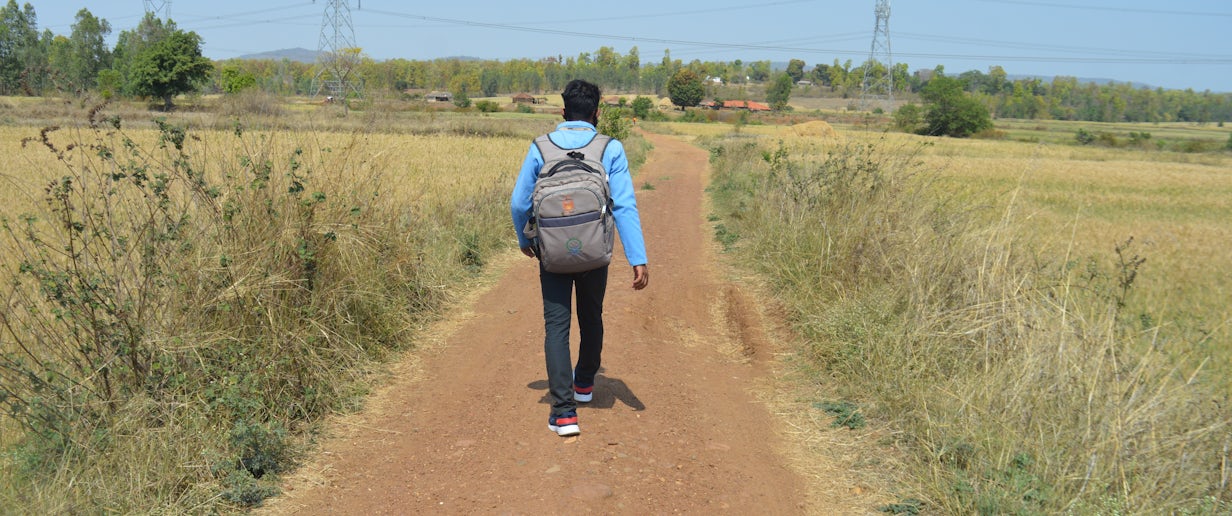Pioneering the Science of Malaria Elimination in Asia Pacific
by APLMA •

Field worker traveling between villages on foot in Mandla, India. Credit: MEDP Mandla 2021
With decades of progress in reducing malaria cases and deaths, the Asia Pacific region is now poised to accelerate its efforts towards malaria elimination using a science-based approach. By enhancing programmatic efficiency and applying evidence-based best practices alongside existing tools, the region is committed to scientifically advancing towards the goal of eliminating malaria by 2030.
On January 18 2024, APLMA published a peer-reviewed policy brief titled “Science of malaria elimination: using knowledge of bottlenecks and enablers from the Malaria Elimination Demonstration Project in Central India for eliminating malaria in the Asia Pacific region” in the Frontiers in Public Health.
This paper introduces the term ‘Science of Malaria Elimination’ and studies the key enablers from the Malaria Elimination Demonstration Project, a public-private partnership in the highly endemic tribal district of Mandla in central India, to inform possible solutions to the challenges faced in the region.
“The scientific and management practices outcomes from the malaria elimination project conducted in the Mandla district in India have produced important key insights into challenges and enablers to achieve malaria elimination in a time-bound manner. Through curating context-specific approaches rooted in the Science of Malaria Elimination, these findings can inform malaria elimination strategies in rest of India and other countries in the Asia Pacific region.”

Reaching the last mile using the Science of Malaria Elimination
The goal of eliminating malaria from the Asia Pacific hinges on a multifaceted approach encompassing a deep understanding of social behaviours, environmental factors, mosquito behaviours (entomology), and patterns of disease spread (epidemiology). This comprehensive knowledge base is pivotal for developing and executing targeted case management and vector control methods. Collectively, these components constitute the Science of Malaria Elimination, which serves as the foundation for devising a range of strategies to eliminate malaria.
The Malaria Elimination Demonstration Project (MEDP) in Mandla, Central India, is an excellent case study for the Science of Malaria Elimination research, successfully identifying key elements that can help overcome technical and programmatic challenges in malaria elimination.
“Today, much of India’s malaria burden is concentrated in hard-to-reach areas and tribal communities. The success in Mandla, with a large tribal population, shows that the Science of Malaria Elimination established here has strong potential to support the last mile of malaria elimination in India and in Asia Pacific.”

Identifying challenges and best practices with the Science of Malaria Elimination
The study identified technical challenges such as low-density malaria infections that are difficult to detect with conventional methods, requiring more sensitive diagnostic tools. Enablers included strategies like Mass Screening and Treatment (MSaT), which effectively identified and addressed low-density infections.
Programmatic challenges included issues like capacity building of frontline staff and surveillance systems. Effective enablers were the development of robust monitoring frameworks and digital tools like the SOCH app, which streamlined data collection and improved efficiency.
Policy-related challenges involved inadequate advocacy and inter-sectoral coordination. Effective advocacy strategies and better coordination among various sectors served as key enablers, improving the overall effectiveness of the malaria elimination efforts.
“Within four years, the Malaria Elimination Demonstration Project (MEDP) in Mandla, Madhya Pradesh achieved a significant reduction in indigenous malaria cases in the study area. These encouraging results can inform programmes and policies to achieve the national and regional goal of eliminating malaria by 2030.”

Improving health outcomes in Asia Pacific with the Science of Malaria Elimination
The findings from the MEDP are not just relevant for Mandla or India but hold significant implications for the entire Asia Pacific region. They offer a blueprint for malaria elimination in similar environments.
The Science of Malaria Elimination provides a roadmap for future efforts in the Asia Pacific region. It is a testament to the power of innovative strategies, community involvement, and collaborative efforts grounded in scientific evidence for the fight against malaria.
“Several countries in Asia Pacific, including Sri Lanka and China, serve as models for successful malaria elimination though the region still sees millions of malaria cases every year, especially amongst our most vulnerable. The Science of Malaria Elimination provides a rigorous, systematic and pragmatic approach to delivery which can inform programmes in service of helping the Region’s last mile communities achieve malaria elimination by 2030.”
Stay Updated
Sign up to receive updates about Malaria free Asia Pacific
You are now subscribed. Thank you!






